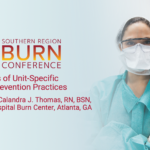Abstract | March 2, 2021
Benefits of Unit-Specific CLABSI Prevention Practices
Learning Objectives
- Upon completion of this lecture, learners should be better prepared to prevent CLABSIs for intensive care patients and clinical staff will recognize the importance of unit-specific prevention methods for central line infections. The practices that will be discussed in the presentation will demonstrate how valuable communication is between nurses and the interdisciplinary team.
Background: Hospital Acquired Infections (HAI), more specifically central-line associated bloodstream infections (CLABSIs), presents numerous concerns in a hospital setting by increasing mortality/morbidity rates and hospitalizations in intensive care units. Burn patients typically have an increased risk for CLABSIs due to the nature of their injuries, and because of their need for long-term antibiotic therapy and medication infusions through central lines. Throughout the years, centers have put in place guidelines and prevention practices in hopes of eliminating these infections, however, there are often variations between medical specialties. In efforts to reduce this disparity, the Burn Center at Grady Memorial Hospital reviewed current policies and constructed a unit-specific CLABSI bundle that would decrease the rate of central-line infections on the unit, which was observed through an evidence-based study. The purpose of this poster is to present the prevention and maintenance interventions that were developed in our CLASBI bundle.
Methods: This study focused on a myriad of components, such as, the ideal central-line placement location, the frequency of dressing changes, the practices prior to dressing changes, the disinfecting process and frequency, the how and when to scrub the central-line site, and the specifics of different dressing uses. More specifically, we advocated that internal jugular placement was ideal, and that dressings should be replaced when the patient returns from surgery or hydrotherapy, when the dressing is no longer dry and intact, and/or every seven days by our central line team. Our nurses practiced bedside audits during shift change to address any maintenance and line necessities, and wiped down patient bedrails and lines with disinfectant wipes twice a day. During dressing change, our team increased the CHG skin prep scrub to 2 minutes using a sand timer, altered the methods of scrubbing the insertion site and external catheter, and activated Acticoat 7 using sterile water instead of saline when sub view dressings were not recommended. In addition to adjusting CLABSI prevention procedures, our team enforced nursing education by having dressing change in-services, verbal and written reminders, quick cards, and informal education between colleagues.
Results: When using the standard policies for CLABSI preventions, through the span of five months, our unit still had an average of 1.4 CLABSIs per month. However when we implemented our burn specific CLABSI prevention bundle, our unit remained infection-free for a year.
Discussion: Our results indicate that the combination of multitudinous interventions lead to a significant reduction of CLABSI rates in our unit, despite the enhanced risk factors burn patients possess. The unit specific CLASBI prevention bundle encouraged nurses to become more attentive and demonstrated the importance of regular communication and transparency between the clinical staff and CLABSI team. Overall, the results from this study showed an inverse relationship between proper techniques and collaboration between staff to the rate of CLABSIs.
References and Resources
- CDC Guidelines for Prevention of Intravascular Catheter-Related Infection,2011
- The Joint Commission. Preventing Central Line-Associated Bloodstream Infections: A Global Challenge, a Global Perspective. Oak Brook: Joint Commission Resources; 2012.
- Mosby Skills Plus Nursing Procedures

